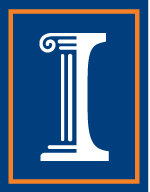Overview:
Carbon nanotubes and semiconductor nanowires
are tiny objects (1000 times thinner than a human hair) that have recently drawn
considerable attention in the scientific and engineering communities on account of
their novel structural and elecrical properties. Transistors, the heart of any
electronic device, from
a cell phone to a robot, can be made of these objects and thus become extremely small,
about 100 times smaller than existing devices. However, the operation of the nanotube
(and nanowire) transistor is governed by physics which is different from what we learn
in classical textbook. A collaborative team of Dr. Rotkin, Research Assitant Professor
at Beckman Institute UIUC, and Dr. Shik and Dr. Ruda, faculty at Toronto University,
Canada, developed a model that works for this novel type of transistor. Surprisingly,
two very different systems: one-shell cylinders of scrolled graphite monolayer - carbon
nanotubes, and thin rods of a semiconductor material - nanowires, may have a common
mathematical model describing transport of charge carriers (electrons) in their 1D
transistor channels. Researchers thoroughly studied how the transistor geometry,
quality of electric leads and temperature influence main working charateristics of
these nanodevices. This theory would provide valuable support for resrearch groups
working on fabrication of nanodevices (IBM, Stanford, Cornell, Delft, Harvard and other).
This work was recently reported in the August 25th issue of Applied physics Letters.

FIG. 1. Current voltage curves for a nanotube based transistor.
|
A detailed understanding of the electronic physics of carbon
nanotubes has allowed Professors Rotkin and Carney to compute the liner optical response
of carbon nanotubes. This work was carried out in collaboration with Yan Li, a graduate
student in physics and a young woman with a very promising scientific career ahead of her.
These results will be very valuable in the design of nano-tube based microscopes. The
nanotubes exhibit an somewhat exotic effect called a nonlocal response. As a result,
the nanotube will interact in very different ways depending on the angle at which light
falls on the tube and the polarization of the light. As a result, when used as a scanning
microscope probe, the nanotube will selectively interrogate certain feature or components
of the sample called Fourier components. The figure below displays the Fourier space coverage
of the information obtainable with a carbon nanotube for certain angles of observation and
polarizations of light.

FIG. 2. The Fourier space coverage of the measurements attainable
with a nanotube based near-field microscope. The plots were made
assuming only one component of the field scattered from the nanotube
could be measured (the component of E is indicated at the top of each
plot) and the incident field consisted of only one type of field,
either TE or TM.
|
Understanding the behavior of the nanotube in this way will
enable the design of new microscopes. Microscopy is important is nearly all fields of modern
engineering and, of course, the biosciences. Some of this work has been reported in seminars
at UIUC and is about to be submitted for publication.
In a prime example of synergy in research, some of the
mathematical advances made in the course of this research were important in a seemingly
unrelated work by Professor Carney. That work demonstrated the first ever example of computed
imaging applied to photon scanning tunneling microscopy and is currently being considered for
publication in Physical Review Letters.
References:
This project is being funded by an NSF NER grant.
See theFunding page for more details
|
